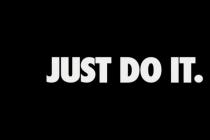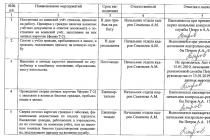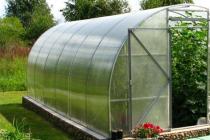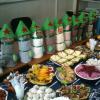The ritual business, despite its specific gloomy connotation, brings huge profits to its owners. There are many formats and options for funeral services, ranging from funeral brigades and welding workshops involved in the manufacture of fences, crosses, benches and tables, to organizations providing a full range of services. But most profitable direction was and still is the production of monuments.
Brief business analysis:
Business setup costs:200-1200 thousand rubles
Relevant for cities with a population:from 10 thousand people
Situation in the industry:high competition
The complexity of organizing a business: 3/5
Payback: 1.5-2 years
Setting up a business for the manufacture of monuments is an idea that requires quite a significant investment. As a rule, funeral homes that do not have sufficient initial capital, come to this 2-3 years after the start of their activities, after they earn a certain reputation, accumulate money, delve into the intricacies of the business - in general, they “boil” a little in this “cauldron”.
Business plan for making monuments
It does not matter at all whether a business is organized from scratch or created as an addition to an existing one, it is imperative to draw up a business plan for the manufacture of monuments. This document will allow you to avoid many annoying mistakes that are common to a novice entrepreneur or a businessman who is trying a new business for himself.
Granite tombstones are the most popular and most expensive in the ritual market. Products made from this material look very beautiful and luxurious, have a certain choice of color palette (black granite, gray, white, red), but have a number of disadvantages:
- over time, the polished surface of the monument fades;
- greasy stains from bird droppings, lipstick (it happens that visiting female relatives kiss the tombstone, leaving traces of lipstick) leave ugly marks;
- letters and numbers on the monument become clogged with dirt and dust over time;
- scratches may remain on granite from large fallen branches from nearby trees, or as a result of the fall of the monument due to improper installation of the stele;
- granite monuments need regular specific care.
Almost all of these unpleasant nuances, of course, can be eliminated, but this requires additional money and time. And, nevertheless, the demand for granite monuments is very high. The approximate cost of the product is determined based on the model of the monument, the dimensions of the granite slab (thickness*height*width), the selected pattern, and varies from 25,000 to several million rubles.

Material supply
The material for the manufacture of monuments differs not only in color, but also in the place of extraction. One of the most expensive and high-quality is Karelian granite, which has a fine-grained structure, which means it is more resistant to splits. This stone is completely impervious to water, which is also important.
Chinese granite, which will be discussed below, has a porous structure, falling into which raindrops expand in frost, tearing the stone and forming cracks.
It is in Karelia that not only black, but also gray and red granite is mined, products from which look very beautiful and unusual.
The properties of Karelian granite make it possible to process it with various tools, combining a smooth polished surface with an unprocessed and rough one in one monument.
Buying blanks for monuments through intermediaries means spending extra money, but if you don’t have your own transport capable of transporting large quantities of stone, you still have to purchase desired material through third parties.
It is very easy to find direct wholesale suppliers who are engaged in the extraction and preliminary processing of stone in Karelia - almost every company has its own website on the Internet indicating the terms of delivery, prices, etc.

But there is one nuance: the developers of the deposits work only on the supply of very large wholesale lots, which the ordinary owner of a granite workshop is unlikely to be able to overpower for money. Here, the benefit of resellers becomes clear, who, when purchasing material in large volumes, sell it in smaller batches, of course, receiving their commissions for this.
In general, there are many companies in Russia involved in the mining and processing of granite. But other types of stone are less known than Karelian, and are used mainly in the regions where they are mined.
Chinese granite is the cheapest material, the quality of which is fully consistent with the price. Nevertheless, monuments made of such stone are also in great demand due to their cost.
Chinese material, as a rule, is notable for its heterogeneous structure and original "spotted" color scheme. Deliveries to Russia and sales of stone are made official dealers Chinese companies. Of course, sales here are often not without intermediaries, so you need to look for cooperation only authorized organizations.
Another type of granite widely used for the production of monuments is Ukrainian. There are many deposits of granite on Nezalezhnaya, from names settlements the names of the stone also occurred:
- Pokostovsky granite (with a fine-grained structure);
- Lukovetsky, Leznikovsky (medium-grained structure);
- Kapustinsky, Korninsky (coarse-grained structure).
In connection with today's rather difficult and tense situation in Ukraine, the supply of natural granite from the country to Russia has fallen somewhat, but the channels have not been completely blocked.
The undoubted advantage is that Ukrainian suppliers themselves resolve issues with delivery and customs. A bonus is also a slight decrease in material prices due to a decrease in demand for granite from Ukraine due to the same unstable situation in this country.
You can find suppliers from neighboring Ukraine either on the Internet or through other ritual agencies.
Less demanded, imported into the country in limited quantities, other types of granite - Italian, Indian, Kazakhstani - are not widely used - the overhead costs for their delivery are too high.
Production technology
For the production of monuments from granite, it is necessary special equipment which does the main job. The days of Danila the master, sitting with a chisel and a mallet near a granite stele, are long gone. Now everything is done by automation.
The complete scheme for the manufacture of monuments from granite, from the acceptance of an order to the acceptance of work by the client, consists of the following stages:

In some workshops, the service of hand-cutting granite is still left. Such work requires much less equipment in terms of purchasing equipment, but it requires an artist who owns the technique of cutting stone. Now in Russia there are few true masters.
It should be noted that this execution technique looks much more impressive than a monument made on a printer.
Necessary equipment
Various types of necessary equipment for organizing a granite workshop, indicating their characteristics and cost, are indicated in the table:
| Equipment | Brand | Working area, mm | Possibility of engraving without a computer | Engraving depth, mm | Cost, rub. |
|---|---|---|---|---|---|
| laser engraving machine | Mirtels L90170 | 900*1700 | Offline printing from USB or flash card | 0.1-06, customizable | From 520 thousand |
| Matrix impact engraving machine | Mirtels T90170 | 900*1700 | No | 0,1-0,5 | From 310 thousand |
| polishing machine | MS 2600 Wanlong | From 250 thousand | |||
| Hand grinder | "Interskol" | From 2 thousand | |||
| Nozzles for angle grinders | From 250 / piece | ||||
| Set of diamond needles for the machine | From 200/piece |
Fonts for printing, drawings of a specific theme (angels, temples, flowers, etc.) are purchased separately on sites involved in the development and implementation of design solutions for ritual agencies.

Granite boards
Granite boards are a budget option granite monument. It is a slab of granite 2 cm thick, 60 cm high and 40 cm wide. The board is bolted to metal legs, which are buried in the ground or poured with cement mortar.
The cost of such a granite board is from 7 to 9.5 thousand rubles, depending on the region.
Production of marble monuments
Marble is a more brittle material than granite and is the second most sought after material in the ritual tombstone market. The structure of the material makes it possible to produce more complex stone compositions than from granite. But in terms of cost, marble monuments are 1.5-2 times cheaper than granite ones, and appearance little inferior to them.
From a single piece of marble, you can make not only a stele of an intricate shape at the request of the customer, but also a bust or a full-length figure. The texture of marble allows you to quite accurately cut out the smallest nuances from stone, but such work requires the skill of a carver and is not cheap at all.

It is almost impossible to carve a portrait on marble; one can only convey common features. But the visibility of such an image will be very poor. In addition, marble darkens in the rain, merging everything - both the letters and the portrait into one.
Therefore, photoceramic plates of various shapes are mounted on marble monuments, cutting special recesses under them in the stone and “planting” them on a clean cement mortar.
Material supply
The color scale of marble is presented in five tones - white, gray, black, yellow, red. Marble extraction is carried out in many regions of Russia, the most famous of them are:
- Karelian marble;
- Ural marble;
- Altai marble;
- Siberian marble;
- Irkutsk;
- and a deposit in Khakassia.
Agreement for wholesale supply, if possible, it is best to conclude with the developers of the fields. Or in extreme cases, with the first reseller in the link. You can get in touch with such resellers by visiting the fields in person (a costly option), on the Internet (an unsafe option - they can be deceived and turn out to be the third or fourth link in the repurchase chain), or by asking advice from long-working "ritualists".

Production technology
The technology of processing marble monuments is only manual, using improvised tools. Roughly processed slabs brought in are cut with special bridge or multi-blade saws with diamond blades and water supply to the stone so that it bursts and the saw blade does not overheat.
Some craftsmen cut marble with a simple “grinder” with diamond-coated discs. This job requires skill and a lot of experience.
After that, with the help of a chisel and a hammer, the end contour of the future monument is cut down, if a model with cutting was ordered, for example, birch, maple, etc., or the surface and ends of the plate are simply polished with the same "grinder" with special nozzles - "turtles".
The main issue of the owner of the marble workshop is the search for personnel. handmade you can’t trust a beginner with a stone, and real specialists are now rare and ask for a very good salary for their services. As an option, the owner can try to learn how to cut stone on his own, thus saving on qualified personnel.

Necessary equipment
As already mentioned, the main tool of a stone carver in a workshop with a small budget is a “grinder” (angle grinder), a set of chisels, incisors, mallets, hammers and a set of nozzles for angle grinders. You will also have to purchase two or three tables for work and various chemical reagents that shade the color of the stone, give it shine, etc.
All the necessary tools and fixtures will cost about 25-30 thousand rubles (this is, if we assume that the room for work is already available).
Marble boards
As in granite workshops, marble workshops also have economical options for customers - marble boards. Their dimensions are exactly the same as those of granite: 60 * 40 * 2, and at a cost they are much cheaper - from 4 to 5.5 thousand rubles.
Production of concrete monuments
Concrete monuments are the cheapest. Their demand is rather weak. A few decades ago, gypsum monuments were in use, but by now they have become obsolete. According to experts, the same will soon happen with concrete monuments.
The technology for the production of such monuments is very simple and resembles the technology for making paving slabs:
- a concrete solution is prepared in a concrete mixer with the addition of dyes and strengthening agents, if necessary.
- The finished solution is poured into a mold placed on a vibrating table.
- The included vibrating table compacts the solution.
- The form is removed and left to dry for several days.
- After 3-5 it, the product is taken out of the mold, its back surface is processed. The monument is ready.

Monuments from a marble crumb
Approximately according to the same scheme, monuments are made from marble chips. Just before the concrete solution is poured into the mold, marble chips are poured into it, which remain after processing the marble slabs. In this case, the cement mortar acts as a link, and not as the main filler.
After the product is removed from the mold, the surface of such a monument is polished. It turns out quite a beautiful stele. Such monuments are also in demand.
Business registration
Obtaining any special licenses and permits for organizing the production of monuments is not required. Entrepreneurial activity you can register as an individual entrepreneur or register a limited liability company - there is not much difference.
The nuances of registration are only that if several people are going to run a business, the IP status will not work. After registering a company, you must choose a taxation system. You can learn about the types of tax regimes in Russia and choose the most suitable one at this link -.
Marketing component of the business
- newspaper ads;
- street banners;
- seasonal discounts (usually winter, because in winter period there are very few orders for monuments);
- discounts for ordering two or more monuments;
Business development may consist in diversifying production - organizing the production of photoceramic plates, opening a welding workshop for the manufacture of fences and other ritual products.

Cooperation with government authorities
Sitting in an agency and waiting for clients to arrive with an order for a monument, even despite the most aggressive advertising, is inappropriate. Now many funeral agencies enter into contracts with government agencies, for example, with district military registration and enlistment offices, services social protection the population, etc.
The fact is that relatives of buried veterans, pensioners who are entitled to some kind of benefits (these usually include Heroes of Labor, honored workers, etc.) have the right to install new monuments at the burial sites of their relatives, which they often use.
In such cases, state structures turn to ritual bureaus with which they have an agreement. The earnings of workshops for the manufacture of monuments are becoming relatively stable. And the installation of steles, on which you can also make very good money, is carried out several times a day.
On monuments and tombstones can be arranged highly profitable business considering all possible pitfalls. First of all, you need to study the level of competition in your region. Sometimes even one manufacturer in a small town can cover all the demand. But often such companies specialize in the production of one type of monuments. Therefore, it is important to first study what the competitors' business is based on, and then choose your own direction.
- memorial complex - in this case, in addition to the monument itself, a fence, a small table, and seats are installed;
- sculpture according to an individual sketch;
- concrete or stone cross with or without a photograph;
- a standard rectangular plate with a photograph, name and period of life.
Based on the material used, the monuments are:
- Metal. Usually galvanized metal is taken. It has a low cost, respectively, gives a low profit. Usually organized as an additional production.
- Stone from rocks. Production requires high costs for the supply of raw materials, the purchase of equipment. It is impossible to organize any additional production. Therefore, it makes sense to open such production in big cities.
- Stone from an artificial stone. Raw material - granules of natural stone, bonded polyester resin. Usually, marble chips or polymer granite are purchased for this. Then the production time of the product is noticeably reduced, since such material is easier to process. Advantage this production- outwardly, the products practically do not differ from products made of natural stone.
- Concrete. Often supplemented with stone elements. Inexpensive production, which allows you to simultaneously produce other dimensional elements. The quality of products is not inferior to other types of raw materials.
We draw up a business plan
The business plan should provide for the following stages of starting a business:
- company registration;
- opening of order shops;
- study of production technology;
- organization of production;
- study of product installation technology.
Regardless of the form of business organization, individual entrepreneur or LLC, when registering, you must specify OKVED 26.70.2 (cutting, processing and finishing stone for monuments). If you decide to master the manufacture of concrete products, you must specify OKVED 26.66 (production of products from concrete, gypsum and cement). For taxation, we choose UTII.
It is better to organize a store for sale or an order acceptance point directly at the cemetery. It is also possible in residential, office areas of the city, where there is a large flow of people. It is necessary to purchase office equipment here: furniture, catalogs, office equipment, a signboard, a plate with a work schedule.
The production area should occupy an area of 70 sq. m. The ideal option is to rent space at the factory, but your own garage is also suitable. It is important that equipment and raw materials fit there.
Equipment for concrete products
To pour concrete molds, you will need the following equipment:
- a concrete mixer, which will cost 11.5-16 thousand rubles;
- vibrating sieve to sift sand, cement, which will cost 10-14 thousand rubles;
- vibrating table worth 47-55 thousand rubles;
- molds for manufacturing: from 12 pieces of different shapes, configurations, costing 10-20 thousand rubles. piece (you can save money by buying not hard, but plastic product for 2-4 thousand rubles. thing).
Please note that with an individual sketch, the form must also be made individually to order. It will cost another 23-27 thousand rubles.
Equipment for stone products
This work option requires the purchase of the following equipment:
- hand tools;
- hoist and hydraulic trolley;
- racks;
- circles for fine and rough grinding;
- polishing and engraving tables;
- circles for cutting metals and stones;
- polishing machine;
- cutting machine;
- angle grinders;
- perforator;
- engraving tool.
For marble, granite chips, it is necessary to include exclusively rigid forms in the procurement plan. Sometimes they are replaced with formwork. Be that as it may, the business plan should include the purchase of a welding machine and a grinder. For the latter, the room must be equipped with a drain hole with cleaning. To engrave a stone, you need to buy a special computer machine, which costs from 4 thousand dollars. It is better to hire an engraver to work on it.
Optional equipment
If your business plan provides, among other things, the provision of services for the installation of monuments, you must purchase:
- cement mortar;
- wooden bars;
- pipes with a diameter of 4-5 cm;
- shovel;
- hammer;
- level.
Technology for the manufacture of monuments
The concrete mixture is prepared from three parts of sand, part of cement and plasticizers. To give the product a certain color, you can use the appropriate iron oxide pigments. Separate technologies allow the use of several pigments of different colors.
When processing stone, it should be borne in mind that granite is much harder than marble. To reduce the cost of producing monuments, you can not buy machines, but buy blanks that have already been polished.
To make a slab of marble chips, 3 parts of water and cement, 5 parts of marble are taken, and all this is mixed in a concrete mixer for no more than 5 minutes. Then the mixture is poured into a mold, placed on a vibrating table for 5-7 minutes. After that, the plate is dried for 2 days at a temperature of 16-20 about C, and then incubated for another 2 days. Only after that you can proceed to decorative processing.
Sample Case Calculations
Calculating the profitability of the business, include in the business plan the rental of premises, the cost of blanks for monuments, the cost of engraving. On average, the cost of engraving is from 10 to 50 rubles. Preparation for the monument will cost 4 thousand rubles. This will include a stand and a flower bed. In total, the production of a monument with engraving will cost about 20 thousand rubles.
The payback plan depends on how efficiently it will be built marketing policy. For example, an engraving machine can pay off in 3 months if five orders for portrait engraving are completed every day. The average cost of such work is a thousand rubles.
The topic of the funeral business is frightening and strange for many people. However, it should be borne in mind that such an activity is one of the most profitable. People are born into the world and, having passed their life path are dying. That is why funeral services will be in demand at all times. They are not affected by economic fluctuations, inflation, or any other factors.
Marketing research
Unlike an organization that provides funeral services, a company that makes monuments may not deal with burials. The list of her works will include only the manufacture of tombstones and their installation.
Before organizing a business on monuments, it is necessary to research the market in your region and determine the demand for this service. It is worth remembering that this type of product is very specific. Availability great competition in the face of a couple of large manufacturers dooms an entrepreneur who has just decided to enter this market to failure.
Preparation of documents
In order to open a business you will need:
Register a legal entity;
Organize points where orders will be taken;
Open a production shop;
Conclude agreements with suppliers of materials;
To master the technological cycles of making monuments;
Learn the rules for installing tombstones.
Organization of points of reception of orders
In order for the client to be able to contact you, you need to rent a room. This will be your point for receiving orders for the manufacture of monuments. When choosing a room, give preference to one that is located in a busy place. Additionally, you can take orders at any existing cemetery, where it is desirable to open a pavilion for storing finished products.

Items must be equipped with everything necessary equipment. For normal work, you will need not only office furniture, but also office equipment, a computer, documentation (work orders and receipts). At the reception points, the client should have the opportunity to familiarize himself with the catalogs, which contain photographs of all types of monuments produced.
Opening of the production hall
If you decide to create your own business, the manufacture of monuments in which will be the main direction, then you will need to organize a workshop. The premises can be rented at any plant. As an option, boxing in a garage cooperative may be considered. Depending on the volume of products produced, the area of the premises should be in the range from seventy to two hundred square meters.
Equipment
The production of monuments is carried out only after the purchase of certain equipment and forms. The main required element technological process- vibrating table Its main purpose is to compact manufactured mixtures.
The production of concrete monuments is based on a simple technology. First of all, the form for the future workpiece is selected. Liquid concrete is poured into it. The vibrating table, on which the form for the monument is preliminarily fixed, produces oscillatory movements. result this process is the shrinkage and compaction of the concrete mixture. This technology makes the monument durable and more resistant to weather conditions.
The vibrating table is the main production unit, which cannot be replaced by manual processing material. All other equipment is intended for mechanization only. labor processes. At the same time, it optimizes the number of employees.

Monument making equipment should include a vibrating sieve. This element is next in the list of the most significant aggregates. The sieve is intended for sifting dry cement. As a result of this process, lumps and foreign impurities are removed, which significantly reduce the quality of the product and its appearance.
If the cement is poorly sieved, during the concreting process, the product may become cracked or become pockmarked, which will increase the susceptibility of the surface to erosion.
Vibrating sieve can be replaced by manual screening. However, it is worth remembering that the unit will significantly speed up the process of cleaning the material and allow one employee to be excluded from the staff.
Equipment for the production of monuments includes a concrete mixer in its list. This machine is familiar to everyone who has ever encountered construction work.

The production of monuments begins with the preparation of the concrete mixture. This is important technological stage product manufacturing process. Manual mixing cannot provide the consistency of the concrete mix, which is necessary for the production of a quality product.
The last component of the equipment of the workshop for the manufacture of monuments are molds. They are special matrices for pouring concrete. There can be many forms, because the client needs to be offered various configurations and designs of tombstone elements.
It is advisable to place lifting devices in the workshop. They can be a hydraulic trolley, hoist, etc.
DIY equipment
How to make a vibrating table yourself? First of all, you need an electric motor. A unit operating on a voltage of two hundred and twenty volts is enough. This electric motor must have sufficient power to fulfill its intended role as a vibrator.
The second most important detail will be a perfectly smooth sheet of metal. Its surface must be without the slightest flaw, otherwise the movement of the forms on the table will not vibrate, but jump. In this case, the solution will not be able to be distributed evenly. Some try to fit a sheet of plywood under the surface of the vibrating table. However, this material, due to its lightness, is not able to convey vibrating movements to the form.
When making a table, it is impossible to do without springs. These parts must be made of metal, have sufficient strength and the required diameter.
After the frame is made of pipes and channels, prepared springs are located at its corners. A metal sheet is attached to the top, to the bottom of which the electric motor is screwed.
metal monuments
Tombstone elements can be made not only from concrete. The production of monuments from galvanized steel and metal is very cheap and unpretentious in terms of material and labor costs. However, it should be borne in mind that the manufacture of these products should not serve as the only and main source of income due to its unprofitability. As a rule, metal monuments are produced as a by-product of an enterprise whose main activity is professional welding.
Tombstone elements from facing rocks
The material for such products are marble and granite slabs. During the production process, they must be processed in the form of grinding. This will require the purchase of special machines equipped with diamond discs. Processing of granite or marble is carried out at least six times.
In this case, discs of various degrees of roughness are used. First, a rough surface treatment is performed, and then a transition to finer grinding is carried out. As a result, the stone becomes matte and even.

At the next stage, the natural material is polished to perfect smoothness. To carry out this process, disk machines are also used. A special paste or powder is applied to the stone. After that, it is polished with discs covered with leather, cloth or felt. The result is a shiny glossy surface.
Decoration
The last step in the process of making a monument is drawing images on it. The artistic design of granite products is a carving of a portrait, surname, name, patronymic, dates of life, etc. It is carried out directly on granite.
Currently, the decoration of monuments is carried out using a computer. So, the photo is processed first. After that, a font is selected that should match the design of the monument.
Computer graphics allow you to get more expressive and clear portraits, as well as inscriptions that will be saved long time. The process of decorating a monument consists in transferring a portrait of a person from a photograph to a tombstone. It should be borne in mind that it differs from manual knockout in higher quality and accuracy.
1. Terms and definitions In this agreement on the processing of personal data (hereinafter referred to as the Agreement), the following terms have the following definitions: Operator - IP Dneprovskiy Oleg Alexandrovich. Acceptance of the Agreement - full and unconditional acceptance of all the terms of the Agreement by sending and processing personal data. Personal data - information entered by the User (subject of personal data) on the site and directly or indirectly related to this User. User - any individual or entity, which successfully completed the procedure for filling in the input fields on the site. Filling in the input fields - the procedure for sending the User's name, surname, phone number, personal e-mail address (hereinafter referred to as Personal Data) to the database of registered users of the site, carried out in order to identify the User. As a result of filling in the input fields, personal data is sent to the Operator's database. Filling in the input fields is voluntary. site - a site hosted on the Internet and consisting of one page. 2. General provisions 2.1. This Agreement is based on the requirements federal law dated July 27, 2006 No. 152-FZ “On personal data” and the provisions of Article 13.11 on “Violation of the law Russian Federation in the field of personal data” of the Code on administrative offenses Russian Federation and applies to all personal data that the Operator can receive about the User while using the Site. 2.2. Filling in the input fields by the User on the Site means the User's unconditional consent to all the terms of this Agreement (Acceptance of the Agreement). In case of disagreement with these conditions, the User does not fill in the input fields on the Site. 2.3. The User's consent to the provision of personal data to the Operator and their processing by the Operator is valid until the termination of the Operator's activities or until the withdrawal of consent by the User. By accepting this Agreement, and going through the Registration procedure, as well as making subsequent access to the Site, the User confirms that he, acting of his own free will and in his own interest, transfers his personal data for processing to the Operator and agrees to their processing. The User is notified that the processing of his personal data will be carried out by the Operator on the basis of Federal Law No. 152-FZ of July 27, 2006 “On Personal Data”. 3. List of personal data and other information about the user to be transferred to the Operator 3.1. When using the Operator's Website, the User provides the following personal data: 3.1.1. Reliable personal information that the User provides about himself when Filling in the input fields and / or in the process of using the services of the Site, including last name, first name, patronymic, phone number (home or mobile), personal e-mail address. 3.1.2. Data that is automatically transmitted to the services of the Site during their use using the software installed on the User's device, including IP address, information from Cookies, information about the User's browser (or other program that accesses the services). 3.2. The Operator does not verify the accuracy of personal data provided by the User. At the same time, the Operator proceeds from the fact that the User provides reliable and sufficient personal information on the issues proposed in the Input Fields. 4. Purposes, rules for the collection and use of personal data 4.1. The Operator processes personal data that is necessary for the provision of services and the provision of services to the User. 4.2. The User's personal data is used by the Operator for the following purposes: 4.2.1. User identification; 4.2.2. Providing the User with personalized services and services (as well as informing about new promotions and services of the company by sending letters); 4. 2.3. Maintaining contact with the User, if necessary, including sending notifications, requests and information related to the use of services, provision of services, as well as processing requests and applications from the User; 4.3. During the processing of personal data, the following actions will be performed: collection, recording, systematization, accumulation, storage, clarification (updating, changing), extraction, use, blocking, deletion, destruction. 4.4. The user does not object that the information specified by him in certain cases may be provided to authorized government bodies Russian Federation in accordance with the current legislation of the Russian Federation. 4.5. The User's personal data is stored and processed by the Operator in the manner prescribed by this Agreement for the entire period of the Operator's activities. 4.6. The processing of personal data is carried out by the Operator by maintaining databases, automated, mechanical, manual methods. 4.7. The Site uses cookies and other technologies to track the use of the Site's services. This data is necessary for optimization technical work Website and improve the quality of services. The Site automatically records information (including URL, IP address, browser type, language, date and time of request) about each visitor to the Site. The user has the right to refuse to provide personal data when visiting the Site or disable cookies, but in this case, not all functions of the Site may work correctly. 4.8. The confidentiality conditions provided for in this Agreement apply to all information that the Operator can receive about the User during the latter's stay on the Site and use of the Site. 4.9. The information publicly disclosed during the execution of this Agreement, as well as information that can be obtained by the parties or third parties from sources to which any person has free access, is not confidential. 4.10. The Operator takes all necessary measures to protect the confidentiality of the User's personal data from unauthorized access, modification, disclosure or destruction, including: ensures constant internal verification of data collection, storage and processing processes and security; provides physical security data, preventing unauthorized access to technical systems, ensuring the operation of the Site, in which the Operator stores personal data; provides access to personal data only to those employees of the Operator or authorized persons who need this information to perform duties directly related to the provision of services to the User, as well as the operation, development and improvement of the Site. 4.11. With regard to the User's personal data, their confidentiality is maintained, except in cases where the User voluntarily provides information about himself for public access to an unlimited circle of people. 4.12. The transfer by the Operator of the User’s personal data is lawful upon reorganization of the Operator and transfer of rights to the Operator’s successor, while the assignee shall transfer all obligations to comply with the terms of this Agreement in relation to the received personal information. 4.13. This Regulation applies only to the Operator's Website. The Company does not control and is not responsible for the websites (services) of third parties to which the user can follow the links available on the Operator's Website, including in search results. On such Sites (services), other personal information may be collected or requested from the user, and other actions may also be performed 5. Rights of the user as a subject of personal data, change and deletion of personal data by the user 5.1. The user has the right: 5.1.2. Require the Operator to clarify his personal data, block or destroy them if the personal data is incomplete, outdated, inaccurate, illegally obtained or not necessary for the stated purpose of processing, as well as take legal measures to protect their rights. 5.1.3. Receive information relating to the processing of his personal data, including information containing: 5.1.3.1. confirmation of the fact of processing personal data by the Operator; 5.1.3.2. the purposes and methods used by the operator for processing personal data; 5.1.3.3. name and location of the Operator; 5.1.3.4. processed personal data relating to the relevant subject of personal data, the source of their receipt, unless a different procedure for the submission of such data is provided by federal law; 5.1.3.5. terms of processing personal data, including the terms of their storage; 5.1.3.6. other information provided for by the current legislation of the Russian Federation. 5.2. Withdrawal of consent to the processing of personal data can be carried out by the User by sending the Operator a corresponding written (printed on a tangible medium and signed by the User) notification. 6. Obligations of the Operator. Access to personal data 6.1. The Operator undertakes to ensure the prevention of unauthorized and non-targeted access to the personal data of the Users of the Operator's Website. At the same time, authorized and targeted access to the personal data of the Users of the Site will be considered access to them by all stakeholders implemented within the framework of the objectives of the activity and subject matter of the Operator's Website. However, the Operator is not responsible for any possible failure intended use personal data of Users, which occurred as a result of: technical problems in software and in technical means and networks beyond the control of the Operator; in connection with the intentional or unintentional use of the Operator's Sites not on their intended purpose third parties; 6.2 The operator takes the necessary and sufficient organizational and technical measures to protect the user's personal information from unauthorized or accidental access, destruction, modification, blocking, copying, distribution, as well as from other illegal actions of third parties with it. 7. Change of the Privacy Policy Statement. Applicable law 7.1. The Operator has the right to make changes to this Regulation without any special notice to the Users. When making changes to current edition indicates the date of the last update. The new version of the Regulations comes into force from the moment of its publication, unless otherwise provided new edition Provisions. 7.2. This Regulation and the relationship between the User and the Operator arising in connection with the application of the Regulation shall be governed by the law of the Russian Federation. I accept I do not acceptFor many years, the manufacture and sale of monuments has been quite profitable business. However, many aspiring businessmen who open such a business do not receive the expected profit due to fierce competition. According to statistics, in small towns in which at least two monument manufacturing companies already operate, it is already quite difficult to find free niche for profit. That is why, before starting a business for the manufacture of monuments, you need to carefully consider a business strategy.
Introduction to the manufacturing process
Before proceeding with the production of monuments, you need to find out from what material the monuments are produced by competitors firms that provide similar services in the same city. Often, each company specializes in the manufacture of monuments from one or more materials. In addition, you need to learn in detail the technology of manufacturing monuments and the list necessary tools and equipment for fast and high-quality execution of orders. If a novice businessman is not going to fulfill all orders on his own, which would be extremely unreasonable, you should also take care of selecting employees who know the manufacturing and processing technology well.
Popular production materials
One of the easiest materials to process is tin and metal. Monuments made of such materials are cheap and therefore always in high demand. However low price and large volumes of work often do not lead to the expected profit. Another popular material that is in great demand is granite and marble. However, only large enterprises with a large staff and special equipment for processing can specialize in the production of such products. hard materials. A small enterprise is unlikely to cope with large or medium volumes, and a lot of processing time will be spent. The most optimal option, easy to manufacture, durable and having a moderate cost, is concrete. Concrete monuments are also in demand due to the possibility of creating additional decorative elements several years after production and installation. To start a business, you will need to purchase a vibrating sieve, a molding table and a concrete mixer. Naturally, it will be necessary to acquire several different forms from which the monuments will be cast.
Related content:

A resident of Israel can start a business of putting notes in the Wailing Wall, a resident of England can start a business of sending greetings from ...-
Every person must know the fire safety rules, since his life and the lives of other people depend on it. With the necessary... -
Features of the sale of state property According to the Federal Law "On Privatization" adopted in December 2001, the sale of state property ...














